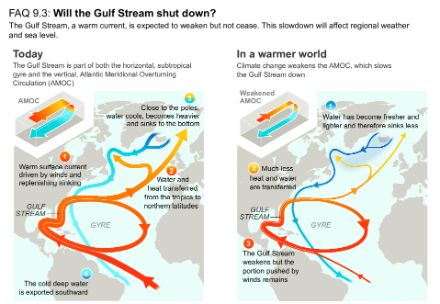Service Navigation
Search
The Gulf Stream is the warm ocean current at the sea surface between the east coast of Florida and the geographical latitude of North Carolina (dark orange in Figure 1). At this location, the surface current with an average width of around 50 kilometres bends eastwards towards Europe. This is due to the predominant westerly winds and the Coriolis force. In the open North Atlantic, the Gulf Stream mixes with cold water from the Labrador Sea and becomes the North Atlantic Current.
The Gulf Stream is part of two larger circulation systems in the North Atlantic: the AMOC and the North Atlantic Gyre. The Gulf Stream is largely driven by winds and only to a lesser extent by the density-driven AMOC. The AMOC is the current that is largely responsible for the warm climate in Europe and is often mistakenly equated with the Gulf Stream. The Gulf Stream transports around 90 million cubic metres of water per second (= 90 Sverdrup) eastwards. At around 15 Sverdrup, the AMOC accounts for only a small part of its volume. However, the AMOC turns northwards off Europe, while the continuation of the Gulf Stream, the North Atlantic Current, turns southwards. The AMOC releases a lot of heat into the atmosphere in the colder north and consequently warms (northern) Europe. The North Atlantic Current also transports most of the heat it brings along back to the south.

Will the Gulf Stream collapse?
In the media, we keep reading about the dreaded collapse of the Gulf Stream. This is based on a predicted weakening of the AMOC due to climate change, which is explained in more detail here. This weakening of the AMOC will also weaken the Gulf Stream. But even if the AMOC were to collapse completely, the Gulf Stream would continue to be driven by the westerly winds.
Whether the Gulf Stream is collapsing as a result of climate change is nicely explained by the IPCC in Frequently Asked Question 9.3 from 2021:
